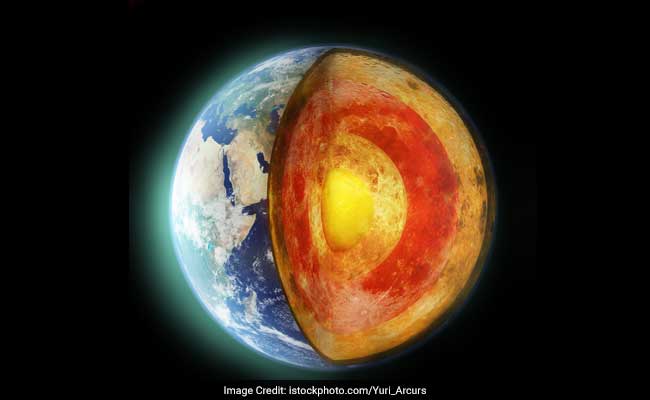Deep within the Earth, a solid metal ball spins independently of our spinning planet, like a top spinning inside a larger top, shrouded in mystery. Since its discovery by Danish seismologist Inge Lehmann in 1936, this inner core has fascinated researchers. Its motion—including its speed and direction of rotation—has been the subject of decades-long debate. Mounting evidence suggests that the core’s rotation has changed significantly in recent years, but scientists remain divided over exactly what’s happening and what it means.
A major challenge is that it is impossible to directly observe or sample the Earth’s deep interior. Seismologists have gathered information about the motion of the inner core by studying the behavior of waves from large earthquakes that reach this region. Differences between waves of similar magnitude that passed through the core at different times have allowed scientists to measure changes in the position of the inner core and calculate its rotation. CNN reported.
“Differential rotation of the inner core was proposed as a phenomenon in the 1970s and 1980s, but it was not until the 1990s that seismological evidence was published,” said Dr Lauren Waszek, a senior lecturer in physical sciences at James Cook University in Australia.
Researchers have debated how to interpret the findings. “The challenge of making detailed observations of the inner core, due to its remoteness and limited data, is the main reason,” Waszek said. As a result, “studies in subsequent years and decades disagreed about the speed and direction of rotation of the inner core relative to the mantle,” she added. Some analyses even suggested that the core was not rotating at all.
A promising model proposed in 2023 described an inner core that had previously spun faster than Earth itself, but was now spinning more slowly. For a time, the core’s rotation matched Earth’s. Then the core slowed even further, eventually moving backward relative to the fluid layers around it.
At the time, some experts cautioned that more data were needed to support this conclusion. Now, another team of scientists has provided compelling new evidence for this hypothesis. Research published June 12 in the journal Nature not only confirms the core’s slowdown, but also bolsters the 2023 proposal that the slowdown is part of a decades-long pattern of speed changes.
The new findings also confirm that the changes in rotation speed follow a 70-year cycle, said study co-author Dr. John Vidale, a professor of earth sciences at the University of Southern California’s Dornsife College of Letters, Arts and Sciences.
“We’ve been arguing about this for 20 years, and I think this is the point,” Dr. Vidale said. “I think we’ve settled the debate about whether the inner core is moving and what the pattern has been over the last few decades.”
Not everyone is convinced the issue has been resolved, however. The implications of the inner core’s slowing down for our planet remain an open question, with some experts suggesting that Earth’s magnetic field could be affected.
Buried about 3,220 miles (5,180 kilometers) deep within the Earth, the solid metallic inner core is surrounded by a liquid metallic outer core. The inner core is composed primarily of iron and nickel and is estimated to be as hot as the surface of the sun — about 9,800 degrees Fahrenheit (5,400 degrees Celsius).
The Earth’s magnetic field pulls on this solid ball of hot metal, causing it to spin. Meanwhile, gravity and the flow of the liquid outer core and mantle exert a drag on the core. Over many decades, the push and pull of these forces have caused the core’s rotation rate to vary, Vidale says.
The movement of metal-rich fluid in the outer core generates electric currents that drive Earth’s magnetic field, which protects our planet from harmful solar radiation. While the inner core’s direct influence on the magnetic field is not fully understood, scientists reported in 2023 that a slower-spinning core could potentially affect it, even slightly shortening the length of a day.
Dr. Vidale and his coauthors observed seismic waves produced by earthquakes at the same locations at different times for this study. They found 121 examples of such earthquakes that occurred between 1991 and 2023 in the South Sandwich Islands, an archipelago of volcanic islands in the Atlantic Ocean east of the southern tip of South America. The researchers also looked at core-penetrating shock waves from Soviet nuclear tests conducted between 1971 and 1974.
The research revealed that the core is now spinning much more slowly and accelerating at different rates, “which needs an explanation,” Dr. Vidale said. The scientists think one possibility could be that the metallic inner core is not as solid as expected.
However, the depth and inaccessibility of the inner core mean that uncertainties remain. However, changes in the nuclear spin can be tracked and measured. The researchers emphasized that when the core spins slowly, the mantle speeds up. This shift causes the Earth to move faster and the length of a day to shorten.
“As for that effect on someone’s life?” he said. “I can’t imagine it means much.”
Featured video of the day
Highlights of Mahayuti meeting: Reasons for LS poll loss deciphered
